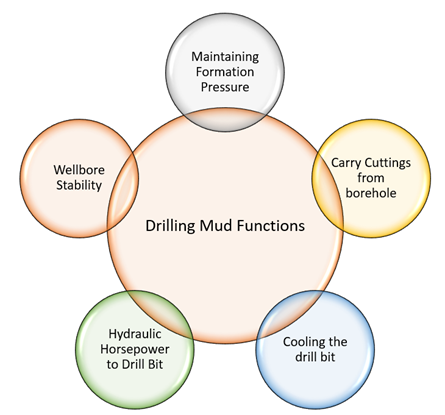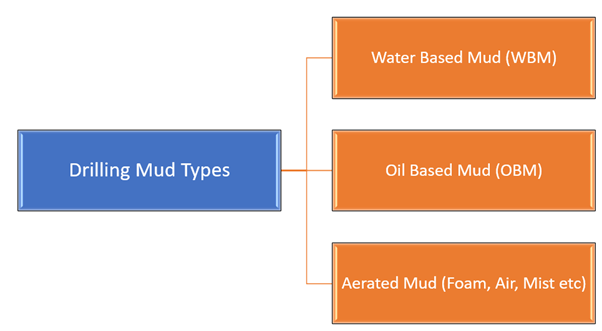Drilling fluid is a thick viscous and heavy mixture that is an integral part of the petroleum drilling process. It is used to bring rock cuttings to the surface from the bottom of the borehole. The fluid also lubricates and cleans the face of the drill bit. In addition to that, it also creates hydrostatic pressure on the walls of the borehole, resisting the formation fluids to enter into the wellbore leading to the stabilization of the wellbore by preventing it from collapse. Drilling Fluid is more often referred to as Drilling Mud.
What is Purpose of Drilling Mud?
Drilling mud is an important ingredient in the drilling process which serves many purposes. Let us discuss some of the most important functions of drilling mud in brief.

Copyright © 2021 Kalkine Media Pty Ltd
- Formation Pressure: Maintaining formation pressure is one of the key functions of drilling mud. It is pumped by mud pumps and it enters the annular space by passing through drilling string and drill bit. In the open hole, mud's hydrostatic pressure is used to counterbalance the formation pressure, which would otherwise allow formation fluids to enter into the wellbore, causing loss of well control. The mud weight must be designed in such a way that it must not exceed the fracture gradient of formation, otherwise, the formation will break down and a significant amount of mud will be lost in the formations as lost circulation mud.
- Carry Cuttings from borehole: Carrying cuttings to the surface of the wellbore is another very important function of drilling mud. The mud carries rock cuttings created by the drill bit. The process allows increasing the rate of penetration by cleaning the face of the borehole and avoiding the regrinding of the rock cuttings.
- Cooling the drill bit: Drilling fluid is also used to cool and lubricate the drilling bit. The drill bit gets heated while cutting the new formations which gets cooled by transferring thermal energy to the drilling mud. The mud also helps to lubricate the drill string as well as the drill bit which increases the rate of penetration, and increases the efficiency of the drill bit, thus avoiding wear and tear of the drill bit.
- Hydraulic Horsepower to Drill Bit: Transferring hydraulic horsepower to drill bit is another very important function of drilling mud. The mud passes through the nozzles present in the face of the bit. The hydraulic energy drop at the drill bit carries the drill cuttings and loosens the formation. The energy is also used to power the mud motors used in directional drilling. It is also used to provide energy to other hardware that is used to get the real-time data from the formation which is usually transmitted through a pulse telemetry system through drilling mud.
- Wellbore Stability: The prime most function of drilling mud is to maintain wellbore stability. The most important aspects of wellbore stability are density regulation, hydraulic erosion minimization, and controlling clays. The density of drilling mud is maintained by slightly increasing the mud weight against formation pressure. Hydraulic erosion is maintained by balancing borehole geometry against cleaning requirements, annular flow velocity, and fluid carrying capacity. Clay swelling is controlled by adding several types of additives into the drilling mud which resists the swelling of clay and avoids shale
What are the Types of Drilling Mud?
There are various types of drilling muds used in the oil and gas industry based on the type and composition of the formation. Some wells require a combination of drilling mud whereas others require a different type of mud for various sections of the borehole. On a broader scale, drilling muds can be classified into three major categories. Let's discuss these major types in brief for better understanding:

Copyright © 2021 Kalkine Media Pty Ltd
- Water-based Mud: A drilling mud that has freshwater or saltwater as the major liquid phase or in the continuous phase. This is the most common type of drilling fluid used in the oil and gas industry. It is relatively less expensive compared to other types of mud systems.
- Oil-based Mud: Oil-based muds have oil in their continuous phase and everything else is mixed into the system. Diesel and mineral oils are few examples of the continuous phase of oil-based muds. This type of mud is used in wells that require increased lubricity, greater cleaning abilities, and enhanced shale inhibition. However, these muds are relatively more expensive than water-based muds.
- Aerated Drilling Muds: Aerated drilling muds use air, mist, and foams as the drilling fluid when drilling through formations having very little or no permeability. Compressed air is pumped into the wellbore with the help of pumps and the returned air carries dust and cuttings with it. Mist is used while drilling wet formations. Foam is preferred in stable formations which may have a moderate influx of water whereas dry air is used for fast drilling.
Drilling Fluid Circulation Cycle:
In a typical oil and gas drilling process, drilling mud is conditioned and toned for recirculation into the wellbore to avoid environmental effects of its disposition and avoid unnecessary expenses, since drilling mud system constitutes a significant portion of the expense incurred in an oil or gas well.
The drilling mud is pumped through mud pits with the help of mud pumps through the drill string. The mud travels through the drill string and sprays out from nozzles present on the drill bit, thereby cleaning the face of the bit while cleaning and lubricating the drill bit. After passing through the drill bit, mud carries the crushed drill cuttings and brings them to the surface passing through the annular space. Drill cuttings are then filtered out on the surface with the help of a shale shaker. After passing through the shale shaker, the mud is kept into mud pits where the remaining fine cuttings settle at the bottom of the mud pits due to gravitational force. The mud is then passed through hydrocyclones to remove other fine materials present in it. Afterward, various additives are added to the mud to get the desired properties of mud so that it can again be pumped into the wellbore.
 Please wait processing your request...
Please wait processing your request...